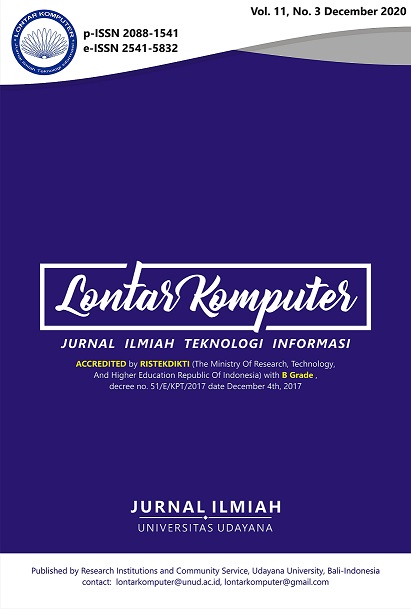Epileptic Seizure Classification using Deep Batch Normalization Neural Network
Abstract
Epilepsy is a chronic noncommunicable brain disease. Manual inspection of long-term Electroencephalogram (EEG) records for detecting epileptic seizures or other diseases that lasted several days or weeks is a time-consuming task. Therefore, this research proposes a novel epileptic seizure classification architecture called the Deep Batch Normalization Neural Network (Deep BN3), a BN3 architecture with a deeper layer to classify big epileptic seizure data accurately. The raw EEG signals are first to cut into pieces and passed through the bandpass filter. The dataset is very imbalanced, so an undersampling technique was used to produce a balanced sample of data for the training and testing dataset. Furthermore, the balanced data is used to train the Deep BN3 architecture. The resulting model classifies the EEG signal as an epileptic seizure or non-seizure. The classification of epileptic seizures using Deep BN3 obtained pretty good results compared to other architectures used in this research, with an accuracy of 53.61%.
Downloads
References
[2] S. Roy, U. Asif, J. Tang, and S. Harrer, “Machine Learning for Seizure Type Classification: Setting the benchmark,” pp. 2–6, 2019.
[3] H. Tjandrasa, S. Djanali, and F. X. Arunanto, “Feature extraction using combination of intrinsic mode functions and power spectrum for EEG signal classification,” Proc. - 2016 9th International Congress on Image and Signal Processing, Biomedical Engineering and Informatics, CISP-BMEI 2016, pp. 1498–1502, 2017.
[4] H. Tjandrasa and S. Djanali, “Classification of EEG signals using single channel independent component analysis, power spectrum, and linear discriminant analysis,” in Lecture Notes in Electrical Engineering, 2016, vol. 387, pp. 259–268.
[5] U. R. Acharya, S. Lih, Y. Hagiwara, J. Hong, and H. Adeli, “Deep convolutional neural network for the automated detection and diagnosis of seizure using EEG signals,” Computer in Biology and Medicine, vol. 100, no. July 2017, pp. 270–278, 2018.
[6] S. Raghu, N. Sriraam, Y. Temel, S. V. Rao, and P. L. Kubben, “EEG based multi-class seizure type classification using convolutional neural network and transfer learning,” Neural Networks, vol. 124, pp. 202–212, 2020.
[7] J. Birjandtalab, M. Heydarzadeh, M. Nourani, and A. Background, “Automated EEG-Based Epileptic Seizure Detection Using Deep Neural Networks,” no. 1, pp. 2–5, 2017.
[8] I. Ullah, M. Hussain, E. Qazi, and H. Aboalsamh, “An automated system for epilepsy detection using EEG brain signals based on deep learning approach,” Expert Systems with Applications, vol. 107, pp. 61–71, 2018.
[9] F. Achilles, F. Tombari, V. Belagiannis, A. M. Loesch, S. Noachtar, and N. Navab, “Convolutional neural networks for real-time epileptic seizure detection,” Computer Methods Biomechanics and Biomedical Engineering Imaging and Visualisations, vol. 6, no. 3, pp. 264–269, 2018.
[10] N. D. Truong et al., “Convolutional neural networks for seizure prediction using intracranial and scalp electroencephalogram,” Neural Networks, vol. 105, pp. 104–111, 2018.
[11] M. Hosseini, D. Pompili, K. Elisevich, and H. Soltanian-Zadeh, “Optimized Deep Learning for EEG Big Data and Seizure Prediction BCI via Internet of Things,” IEEE Transactions Big Data, vol. 3, no. 4, pp. 392–404, Dec. 2017.
[12] M. Liu, W. Wu, Z. Gu, Z. Yu, F. F. Qi, and Y. Li, “Deep learning based on Batch Normalization for P300 signal detection,” Neurocomputing, vol. 275, pp. 288–297, 2018.
[13] Y. Chen et al., “Texts With Deep Learning Approaches,” IEEE Transactions and Intelligent Transportation Systems, vol. PP, no. 8, pp. 1–10, 2018.
[14] D. Macêdo, C. Zanchettin, A. L. I. Oliveira, and T. Ludermir, “Enhancing batch normalized convolutional networks using displaced rectifier linear units: A systematic comparative study,” Expert Systems with Applications, vol. 124, pp. 271–281, 2019.
[15] A. Schindler, T. Lidy, and A. Rauber, “Comparing shallow versus deep neural network architectures for automatic music genre classification,” CEUR Workshop Proceedings, vol. 1734, pp. 17–21, 2016.
The Authors submitting a manuscript do so on the understanding that if accepted for publication, the copyright of the article shall be assigned to Jurnal Lontar Komputer as the publisher of the journal. Copyright encompasses exclusive rights to reproduce and deliver the article in all forms and media, as well as translations. The reproduction of any part of this journal (printed or online) will be allowed only with written permission from Jurnal Lontar Komputer. The Editorial Board of Jurnal Lontar Komputer makes every effort to ensure that no wrong or misleading data, opinions, or statements be published in the journal.
 This work is licensed under a Creative Commons Attribution 4.0 International License.
This work is licensed under a Creative Commons Attribution 4.0 International License.























